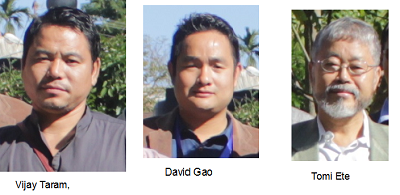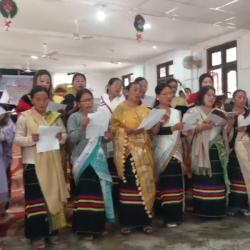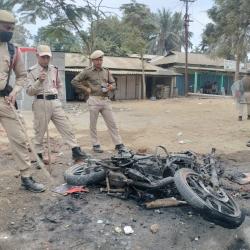People of Pasighat region in Arunachal Pradesh resists big dam building in Siang river, the upstream of the Brahmaputra (Yarlung Zangbo) in India. People of Siang districts in Arunachal Pradesh have been agitating against more dam building on Siang river, the main water flow of Brahmaputra (Yarlung Zangbo) from Tibet, China. In a recent meeting on 'Policy Dialogue for Governance of the Brahmaputra River' held in Itanagar, the capital city of Arunachal Pradesh the anti-dam leaders cleared their position while state government officials and some experts had emphasised dam building on Siang (Brahmaputara). But, the anti-dam movement leaders have not changed their stand.
Both Union and state governments consider hydroelectric power as green power and supporting dam building in the state and approve green signals to companies. Some trans-national river flow from China to India through Arunachal Pradesh. Yarlung Zangbo enters Arunachal Pradesh near Gelling from where it is known as Siang. The total length of Siang River is 294 km till its point of confluence with Dibang and Lohit River at Sadia in Assam. As a riparian state of rivers flowing through Assam, civil societies as well as individuals have been opposing against big dams in Arunachal and Assam. They appealed to different authorities not to give environmental clearance against all mega dams in Siang belt comprising four districts of Siang, East Siang, Upper Siang and West Siang, but Centre turned a deaf ear to those people.
The Siang People's Forum (SPF), Siang Peoples' Forum (SPF) and Lower Siang Dam affected Peoples' Forum (LSDAPF), who have been spearheading the anti-mega dam movement in the Siang valley,had appealed to UPA government and UPA chairman Sonia Gandhi too. They appealed to the BJP-led Central Government not to give environmental clearance. In a memorandum to Union Environment and Forest Minister Prakash Javadekar, the Siang People's Forum (SPF) made it clear the people of the four districts would not compromise on its demand of scrapping all mega dams over the Siang river
But Arunachal Pradesh becomes a state dumped with of dam politics, corruption and betryal. Many big dams are under construction disregarding the opinion of mass people, some constructions are hault by courts and some on the pipeline. Vijay Taram, an anti dam movement leader of Forum for Siang Dialogue said thet he was offered few crore of rupees for not to oppose dam building and abandone the anti-dam movement. He says, "No dam on Brahmaputra (Siang), of course we are not against small dam and dams on tributaries of Siang".

Taram, an environmental activist said "big dams will spoil our lives and livelihood. It will create havoc, spoil biodiversity of both districts by inundating all forest and agriculture lands. The dams, if completed, will flood all fertile agricultural lands, destroy ecology, flora and fauna of entire Siang belt and displace thousands of people of Siang valley. Tribal men will lost their traditional hunting ground as well as culture" Taram said that dam would destroy their agricultural fields, hunting grounds, habitat, wildlife as well as culture and livelihood. "We did get our land neither fro British nor Indians. We owned it from our forefathers. We will protect our alnd and will fight for it" he said.
A report commissioned by the Central Water Commission had recommended 29 dams planned across the Siang river in Arunachal Pradesh. It has also suggested stricter regulations for those are to be built in future. The report notes: "Siang Lower HEP (2,700 MW), Siang Upper Stage II (3,750 MW) and Siang Upper Stage I (6,000 MW) are planned to cover almost the entire length of the Siang in India. 208.5 km of the river will be converted into one continuous reservoir as all three projects are planned back-to-back without any free flowing intermediate river stretch." Once the dams are built, the Siang basin will never be the same again; official studies by the Central Water Commission point out the 44 planned dams within India will change the natural flow of the water in up to 29 rivers and streams. As of now, these rivers and streams stretch out over almost 514 km. Once the dams are built, all of it would be altered -- 353 km will turn into reservoirs, and close to 161 km will be converted into tunnels.
This would inevitably change the basin's 15,000 sq km of forest that hosts an astounding number of flora and fauna. The Siang basin is home to 11 different kinds of forests, 1,349 plant species and 1,197 animal and fish species. The official assessment of the dams' cumulative impact predict that much of this wildlife will migrate, some perhaps forever. Fish species too would find life more difficult once the natural flow of water changes.
In three districts of Siang, not a single villager was informed about the plan and recommendation for dams. Local people still do not know how many dams are being planned in their region. They don't want dam but development of the area and a good market where they can sale their agricultural production. The Government of Arunachal Pradesh has resorted to violence to push forward with the 2700 MW Lower Siang Hydro Electric Project on the Siang River despite stiff opposition from local indigenous communities and peasant and environmental groups, said David Gao.
People weighs the impact of the dams and concludes that the progress it will bring may outweigh any adverse changes. People fears of flash flood too. They witnessed it earlier. In June 2000 Siang flooded, killing at least 30 people. More than 100 went missing. No one expected the flood because there was no rain, and no one believed the government's warnings.
Up to 24,000 hectares of the immediate forest vicinity is expected to be inundated, choking up much of the natural nutrient supply that feed the fish and other water animals, while cutting off the natural routes of some fish species that migrate far to breed. And when men and machinery move into the forest and river banks to begin construction, much more forest cover is likely to be lost since approach roads would reach forests further afield.
David Gao, an anti-dam activist and Assistant Professor of department of Political Science in Rajib Gandhi University says the construction of this mega dam might lead to consequences which will harm the indigenous people. But the role of state governments have been changing with changing governments. On one hand the govenrment declare that it will always aim for the betterment of the people of the region as it is the priority. But on the other hand they do not scrape controversial MOUs which allows different companies to build dams or hydro-electric projects.
People of Siang re "saddened" by the u-turn on the issue by the BJP since it came to power at the Centre. Before the last general election at an election rally in Pasighat Prime Minister Narendra Modi had won the support of dam activists from the area after he stated that he would prefer smaller hydro power projects and honour the sentiments of the region's people. But Modi changed his mind after he had accquired power of central government and took a U turn giving green signal to built 3000 MW big dam for Dibang Hydro electric Project in Dibang Valley in Arunachal Pradesh.
On June 4, ((2016) Union Water Resources Minister Uma Bharati told reporters that "the solution on Brahmaputra's perennial flow lies in middle Siang" and that the river "is the answer for floods in Arunachal Pradesh and Assam". After Tarun Gogoi, then chief minister of Assam claimed that his state had not been informed of any such proposal. His government was for the welfare of the people and it would "not endorse any project which will not benefit them", an official release said. He said the Centre has not consulted the State yet on any such project on middle Siang.
The general secretary of Siang peoples' Forum, Oyar Gao also raised the issue of the river's sanctity saying that the Siang is referred to as Aane (mother) in the same manner as Ganga Maiya. Slamming the plan, the forum questioned the minister for her non-visit of Arunachal Pradesh and avoid stakeholder before making the statement. Siang People's Forum had also joined in to express its opposition. It criticised the Centre's policy on rivers stating that "on the one hand you are diligently busy in Clean Ganga and Save Ganga and on the other hand you are planning a disaster on Siang sitting at Delhi."
But now the BJP led new Assam Government maintaining balance game on the subject. A BJP MLA Ashok Singhal, who earlier led an anti-dam organisation now supports dam-building on Brahmaputra after a quantum jump into party politics to become an MLA from Dhekiajuli constituency. Dam are useful for Assam, he said.
The Siang District belong to to the indigenous communities of the Adi and Galo tribes. Twenty-three of their villages are on the banks of the Siang River that will be directly affected by the project. Tribal people have an umbilical bond with the forests and rivers they inhabit. The rice is staple food of Adi and Galo people and wet rice fields are are situated in land just above the Siang River. Planned dam will Submergence of wet rice field is a significant threat to their right to land and livelihood - their very survival. Anti-dam movement leaders say that their right to free, prior and informed consent (as enshrined by the United Nations Declaration on the Rights of Indigenous Peoples) is not only being ignored, but deliberately avoided.
The main dam is being constructed across river Siang, a tributary of river Brahmaputra and upon completion, the dam reservoir will hold 10 billion cubic meters of water. The hydro power project at Siang will alone generate between 10,000 and 12,000 MW, making it the largest hydroelectric dam in the Indian Subcontinent.
In 2006, Indian media reported that the NHPC was planning to relocate and scale down the project due to concerns on flooding upstream by Chinese government. However, the Arunachal Pradesh government has awarded contracts and commenced work on the project as per initial plans.
Many see the public hearings that are conducted far from the affected areas as merely a rubber-stamping exercise and not one of genuine consultation with the local community on whose land such massive dams are planned to be built. Taram claims the locality where the hearing is scheduled has a population of barely 500 people but over 600 policemen have been deployed to carry through the verdict by threat and fear.
On Monday 16 April, police fired live rounds in the air and used tear gas and rubber bullets to disperse activists who had sought to block access to the Public Hearing scheduled for 17, 18 and 20 April. Two protesters were reportedly injured and several of them assaulted, beaten and humiliated. The hearing itself was canceled on Tuesday when people came out in the streets in hordes and anti-dam activists reportedly burnt the vehicles and site used for the public hearing in retaliation to intimidation from armed individuals deployed by Jaypee Co., who continue to pose a threat to local villagers.
Local opposition to the dam construction had already forced the state government and Jay pee Arunachal Power Limited, the company working on the project, to postpone public hearings three times in the past. The groups argue that the project is against the interests of local communities and will have profound and adverse effects on local ecology, biodiversity and fragile way of life of the state's indigenous tribes. David Gao says "The construction of this mega dam might lead to consequences which will harm the indigenous people. But the role of state governments have been changing with changing government".
On one hand the government declare that it will always aim for the betterment of the people of the region as it is the priority. But on the other hand they do not scrape controversial MOUs which allows different companies to build dams or hydro-electric projects without proper procedure. Sometimes the state government say endorsement of projects which will not benefit the local people is not acceptable by the state government, on the other hand it allows to construct dam without proper procedure and measures.
Local government leaders and retired engineers experts says that dam only produce electricity but also help in regulation of flood. Tomi Ete, a retired Chief Secretary and Commissioner of Public Works Department and Public Health Department asks anti-dam movement leaders to comply with dam building with some new processes because Arunachal Pradesh has limited resources for delopment and next generation.
The signatory companies are pressuring the government to build their projects on the river. Some companies and the government trying to justify with a comparison to China. They claim that since China has built dams on the river in Tibet, India should do the same. Govt of India always try to highlight the dam building by China and want to join the dam race.
During the meeting in Itanagar, Dr P J Das, of Aranyak , a NGO said that China has built dam in a place where life and agricultural land are not affected. He warned that it will be devastating if India abstain from dam building race. The representatives of Siang uphold their position of unanimously opposing any move of constructing the dam tooth and nail stating that the Government never consulted local people before signing the MoU with any company, Govt. undertaking etc.
They further stated that Siang valley has the highest numbers of agricultural paddy fields and horticultural cash crop gardens which is incomparable to any other river valleys particularly Dibang, Lohit and Kameng etc. where hydro power projects are being built or likely. People have feared that all the land properties/ assets lying along either sides of the Siang River are likely to be submerged if the proposed dam is constructed. Few experts, engineers and political leaders emphasised on the need of possessing hydro project which is the basic source for the all round development especially in industrial, technological and tourism sectors.
However, in his summery revision of the conference organised by SaciWATER, Mr Tomi Ete and other experts who support dam building, insisted on the need of possessing hydro project which is the basic source for the all round development especially in industrial, technological and tourism sectors. Arunachal Pradesh has limited resources and limited scope for revenue earning for welfare and development activities. So hydro-power can be the best way for future generations. He said affected agricultural and hunting activities could be compensated with appropriate measures.
Ete further appealed the people to avoid misconception and keep away from rumour which discouraged development of hydro power projects and advised them to rethink for the betterment of future generations. But anti-dam movement leaders did not changed their stand. Interestingly Ete reveals that Government of Arunachal Pradesh earned around 1000 crore rupees and there is no information of these amount. There is no record of either spent by government or deposited in the state exchequer.
Most of those who attended the meeting vehemently opposed the construction of dams on the Siang. But government officers, elected representatives and experts delivered their speech supporting dam building in three districts of Siang region. Government trying to increase dam supporters day by day. Anti dam movement leaders are consistent in their stand. "How long this stand will work in a land where justice goes to majority !" - one protester asked himself.

- 14953 reads










Add new comment